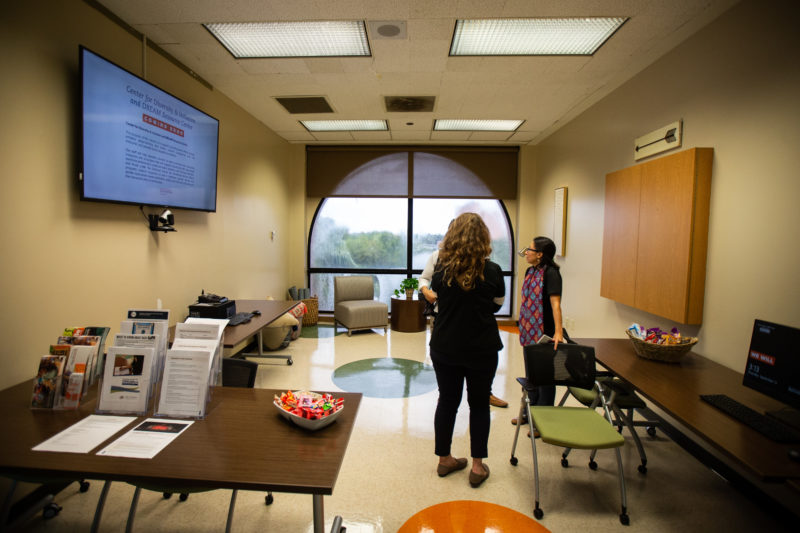At UT-Rio Grande Valley, Help for Undocumented Students Materializes Slowly
By KATE GROETZINGER
Reporting Texas

A DACA student is pictured on Thursday, Sept. 13, 2018, at the University of Texas Rio Grande Valley. (Michael Minasi / Reporting Texas)
EDINBURG – When 20-year-old Maria lost her visa last year, she had already lived in Texas for a decade. She would have had to cross back into Mexico to replace it, risking that she couldn’t return to the U.S. The only other way she could obtain temporary legal status was to apply for the Obama-era program known as Deferred Action for Childhood Arrivals — which protects undocumented immigrants who entered the U.S. during childhood from deportation. Maria (a pseudonym used to protect her privacy) sought help with her DACA application from administrators at the University of Texas at Rio Grande Valley, where she is a student.
“I didn’t know what a Dream Center was, but I was looking for a Dream Center,” Maria said, referring to campus resource centers dedicated to helping undocumented students. UTRGV didn’t have one.
Maria spoke to a student counselor, who referred her to the International Student Office, where a staff member told her about an information session with an immigration attorney. But when she attended the session, she realized she could not ask questions without revealing her immigration status to everyone in the room.
Maria’s experience is common among undocumented students at UTRGV, said Abraham Diaz, a DACA recipient and a 2017 graduate from UTRGV. Diaz remembers “having to jump from office to office at the university and tell my story every single time, so they could finally understand the scenario and send me to another office.”
The frustration experienced by students at UTRGV comes at a time when U.S. immigration policies and enforcement are making life increasingly anxious, even dangerous, for undocumented students around the country. Other public universities in Texas have opened Dream Centers to serve undocumented students’ needs, but bureaucratic inertia slowed that effort at the university with the most undocumented students in the state, UTRGV.
Diaz first called for a Dream Center at UTRGV right after President Donald Trump was elected in November 2016. Trump had seized on anti-immigrant rhetoric during the presidential campaign, referring to immigrants as threatening and dangerous. “There was all of this uncertainty, and we knew this would be a bit of a solution to a huge problem,” Diaz said.
Diaz, who now works as an education specialist for an immigration advocacy group in the Rio Grande Valley, estimates 1,200 undocumented students attend UTRGV. In 2016, Diaz was president of a campus group called the Minority Affairs Council, which delivered a petition with 1,600 signatures to UTRGV President Guy Bailey asking him to establish a Dream Center and adopt policies to protect undocumented students.
In response, Bailey sent a memo to students promising that their immigration statuses would remain confidential and that campus police would not ask if they were undocumented. The memo also promised the administration would “explore the creation of a specific support structure, whether an office or a network of faculty and staff, to make it clearer to these students who to turn to for assistance.”
Bailey said he approved a center for undocumented students in 2016 and that he asked administrators to work with students to design it. Last spring, when the Student Government Association at UTRGV passed a resolution calling for the creation of a Dream Center, Bailey discovered the center still did not exist.
Dean of Students Rebecca Gadson has been in charge of designing and opening the center. “There’s been a gradual effort to get to where we are now,” she said. Gadson said the University was not ready to open a Dream Center in 2016.
The Dream Center at UTRGV — officially called the Center for Diversity and Inclusion — opened in September 2018, and is one of only a few such resource centers in the state. Texas Tech University and the University of Texas-San Antonio both opened centers in 2017, each of which is part of a larger resource center for minority students.

Visitors tour the Center for Diversity and Inclusion during an open house at the University of Texas Rio Grande Valley in Edinburg on September 13, 2018. Michael Minasi/Reporting Texas.
Texas Tech opened its Dream Resource Center in August 2017, after the Trump administration rescinded DACA. Administrators asked undocumented students and DACA recipients what they most needed and tried to incorporate those needs into the center, said Jade Silva, the director of the Division of Diversity, Equity and Inclusion at Texas Tech. The answer was legal services, so the center brought in law students from the university’s law school to volunteer.
“We will continue having those conversations, understanding that students have agency,” Silva said.
The Dreamers Resource Center at UTSA opened in January 2018 in response to demands from students, said UTSA student Andrea Fernandez. Fernandez, a DACA recipient, became the president of the university’s Immigrant Youth Leadership organization in March 2017.
UTSA President Taylor Eighmy asked Fernandez to draft a proposal for an undocumented student resource center in the fall of 2017, Fernandez said. She based her proposal on the Haas Dreamer’s Resource Center at the University of California Berkeley.
The center at UC Berkeley — which offers a dedicated mental health counselor to undocumented students and free legal services through a contract with a legal clinic — is the gold standard of Dream Centers, according to Jesus Cisneros, a researcher at The University of Texas-El Paso.
Cisneros recently completed a comprehensive study of undocumented student resource centers around the country. Cisneros identified 56 such centers. California has the most with 46, while Texas has three, not including the center at UTRGV.
According to the report, the centers in California are older and offer more services than those in Texas, thanks in part to state funding. “The University of California and California State University systems have funding allocated specifically for dreamer centers,” Cisneros said. “In the Texas systems, that’s not a thing.”
The center at UC Berkeley has an operating budget of about $2 million, one-fifth of which comes from the state. The rest is made up of private donations from a few main donors, according to the center’s director, Liliana Iglesias. A major donation from the Haas family allowed UC Berkeley to open the Haas Dreamer’s Resource Center in 2012.
“The Haas family has funded different initiatives on campus,” Iglesias said. “When they heard about the needs of undocumented students from the development office, they were interested.”
According to Cisneros’ report, most centers are run by a full-time director and offer a variety of services, including academic advising, financial aid, mental health counseling and career services. Most centers also do outreach to local high schools to inform students that they can pursue higher education, regardless of their immigration status. But this information isn’t always readily available to schools wanting to start their own centers, Cisneros said. “Institutions often express frustration over not knowing what they can do,” he added.
UTRGV Dean of Students Rebecca Gadson acknowledges that the university took awhile to open its version of a Dream Center, but her office needed time to gather information on what would make the center successful before opening it, she said.
“I don’t know what was the biggest barrier,” Gadson said, “making sure we had resources in place, making sure we could provide support and do it well, [or] wanting to be sensitive to our student population about the fears that our students have, that by going to a Dream Center they may be identifying themselves as undocumented.”